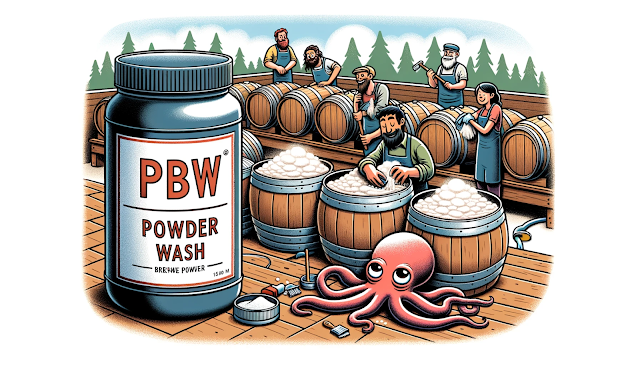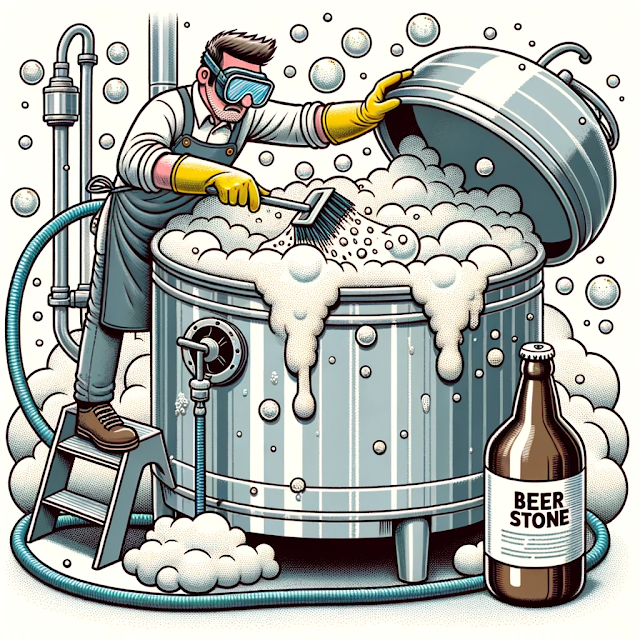PBW's reputation precedes itself. This cleaning agent is celebrated not just for its efficacy but also for the trust it has garnered among North American homebrewing communities.
| Pros | Cons |
|---|---|
| • Effective Cleaner: Excellently removes organic residues such as proteins and lipids. | • Requires Thorough Rinsing: Must be completely rinsed off to avoid residue. |
| • Versatile: Safe for use on all materials including stainless steel, glass, plastic, and ceramics. | • Not a Sanitizer: Cleans effectively but does not have sanitizing properties. |
| • Environmentally Friendly: Biodegradable and non-hazardous under typical use conditions. | • Optimal Performance Requires Hot Water: More effective with warm to hot water, increasing energy use. |
| • Non-Corrosive Formula: Safe on metals and materials used in brewing equipment. | • Cost: Generally more expensive than traditional cleaners, which might affect budget considerations for home or professional brewers. |
Why PBW Shines as a cleaner of beer brewing gear
- Stubborn Residue No More: Those who've brewed know the challenge of cleaning the bottom of a 5-gallon stainless steel boil pot. With PBW, those crusty remnants are effortlessly dissolved.
- Eco-Friendly: PBW's environmentally conscious formula is biodegradable and septic system-friendly.
- Versatile Applications: Beyond brewing equipment, PBW shines in cleaning dishwashers, stainless steel utensils, and even in neutralizing odors from organic substances.
- Safety First: Unlike other chemical agents such as sodium hydroxide, PBW doesn't pose a threat to the skin or emit a strong, undesirable odor.
- Label Remover: Struggling with sticky beer bottle labels? A soak in PBW ensures they slide right off.
Beyond Brewing: The Unexpected Uses of PBW
It's not just brewing equipment that can benefit from PBW's cleaning prowess:Beer Bottles: Let's face it, cleaning dried sediment from the bottom of beer bottles is tedious. Why bother with a bottle brush when PBW can do the job?
Fermenter drums: Even if you've neglected your fermenter for weeks, a soak in PBW will bring it back to its pristine condition. And the best part? No scrubbing required.
The PBW User Manual: How to get the best cleaning results
Using PBW is straightforward:
| Step | Description |
|---|---|
| Step 1: Preparation | Measure the correct amount of PBW for your equipment. Use 1-2 ounces of PBW per gallon of water, depending on the level of soiling. |
| Step 2: Soaking | Soak your brewing equipment in the solution overnight. This extended soak time allows PBW to thoroughly break down and remove organic residues. |
| Step 3: Rinsing | Rinse your equipment thoroughly the next day to remove any residues of PBW. Ensure all surfaces are completely clean to avoid any contamination in your next brewing session. |
| Step 4: Post-Cleaning | Once rinsed, your equipment is ready for another brewing session. Inspect for any remaining residues and ensure equipment is dry before storing or using. |
Cleaning vs. Sanitizing: The Essential Distinction
It's crucial to understand that while PBW excels at cleaning, it doesn't equate to sanitization.Decoding PBW: The Ingredients that Make it Work
At its core, PBW is powered by Sodium Metasilicate, which constitutes about 30% of its formulation.DIY PBW: Crafting Your Own Cleaner
For those looking to replicate the cleaning efficiency of PBW at home, combining TSP/90 (commonly known as Red Devil) with Oxiclean can yield similar results. However, it's essential to note that while percarbonate is more of a sanitizer, metasilicate serves as the cleaner.PBW has carved a hand niche for itself in the brewing world, and rightfully so.




